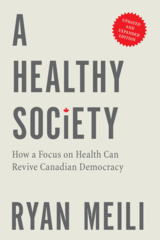
Be Wise! Be Healthy!
Morality and Citizenship in Canadian Public Health Campaigns
Lose weight. Quit smoking. Exercise more. For well over a century, governments and voluntary groups have run educational campaigns encouraging Canadians to adopt health habits that promise to prolong lives, increase our quality of life, cost the state less, and make us more efficient workers.
Be Wise! Be Healthy! explores the history of public health in Canada from the 1920s to the 1970s, a period that saw a massive expansion of education programs through the Health League of Canada. The league, with roots in the moralizing social hygiene movement, urged Canadians to drink pasteurized milk, immunize their children, and avoid extramarital sex. It advocated fluoridating the water supply and counselled Canadians to see health as a responsibility of citizenship – with doctors and dentists as experts to guide them in that duty.
Public health campaigns have reduced preventable deaths. But as Be Wise! Be Healthy! argues, such campaigns can also stigmatize marginalized populations by implying that poor health is due to inadequate self-care, despite clear links between health and external factors such as poverty and trauma. This clear-eyed study demonstrates that while we may well celebrate the successes of public health campaigns, they are not without controversy.
This book will interest public health professionals and students and scholars of the history of medicine and public health in Canada. It will also find an audience among scholars and students of social history, cultural history, gender history, and working-class history as they relate to public health issues.
A fascinating analysis of how a voluntary organization, the Health League of Canada, stimulated public discussions about the health of Canadians. This book pushes the scholarship in new directions by addressing the tensions and synergies between clinical and public health.
Based on impressive primary research, Be Wise! Be Healthy! examines some of the twentieth century’s most significant public health issues. The analysis of post–Second World War public health campaigns is particularly illuminating, covering new ground in Canadian history scholarship. The illustrations bring a strong visual component, and I especially enjoyed the discussion of health films and other public health campaign communication tools.
Catherine Carstairs is a professor in the Department of History at the University of Guelph. Her publications include Jailed for Possession: Illegal Drug Use, Regulation, and Power in Canada, 1920–1961 and Feminist History in Canada: New Essays on Women, Gender, Work, and Nation, edited with Nancy Janovicek.
Bethany Philpott is a family medicine resident at Queen’s University, Belleville-Quinte.
Sara Wilmshurst’s research on the Health League of Canada sparked her interest in nonprofit organizations, and she now works in fundraising.
Acknowledgments
Introduction: Creating Healthy Citizens
1 “Tell Your Children the Truth”: The Canadian Social Hygiene Council and Venereal Disease Education
2 Expanding the Mission: Publicizing Public Health
3 “Stamp Out VD!” The Health League of Canada and Venereal Disease Education during the 1940s and 1950s
4 Preventing Sickness and Absenteeism: The Health League and the Workplace
5 “The Human Factory”: Nutrition, Efficiency, and Longevity
6 Fighting Apathy and Ignorance: National Campaigns
7 “A Malicious, Mendacious Minority”: Fighting for Water Fluoridation
8 Circling the Drain: The League’s Slow Decline
Conclusion: The Successes and Failures of Preventive Health
Notes; Index














